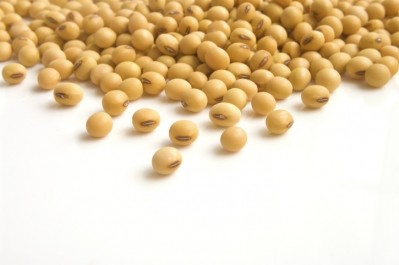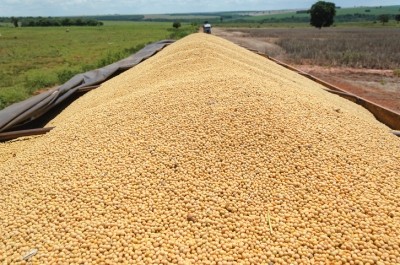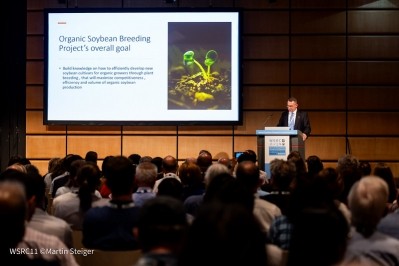Study: As CP content of US soybeans increases with improved selection practice, there are benefits for growers, processors and pig and chicken farmers

This additional value represents the amount that poultry and swine end users could pay for a higher SBM concentration and still have an overall reduced diet cost, confirmed the authors.
Writing in the Journal of Applied Poultry Research, the nutrition experts noted that an understanding of the relative value of SBM as amino acid and energy concentrations change is critical for economic evaluations and planning at all stages of the soybean supply chain.
“The results presented here can be used to communicate the true economic value of SBM based on intrinsic product and compositional characteristics.”
Nutritionists make decisions based on crop quality characteristics such as amino acid concentration and energy content. These parameters tend to decline as soybean yield increases, consequently, the value proposition for SBM is not fully recognized in the market, reads the study.
Protein levels in US soybean meal
There has long been a focus on volume over value in the US soybean supply chain, according to US soy industry consultant, Gordon Denny.
The leading seed technology companies, he told us previously, introduced raffinose and stachyose into soybeans to improve field yields even though it diminished the overall quality and thus the value of the soybean crop. “All they wanted to do was to have higher field yields, and that is easy to do with the infusion of raffinose displacing protein.”
The paper’s conclusions concur with Denny’s comments. The authors noted that, over the past several decades, soybean genotype selections have focused on yield improvements, as measured by weight or volume per area without retaining comparable nutrient composition. This resulted in decreased protein content and decreased concentration of essential amino acids over time. These changes led to a reduction of the amount of SBM used in poultry and swine diets.
That trend has been accelerated by increased use of crystalline amino acids, distillers dried grains with solubles (DDGS), feed enzymes to improve nutrient utilization, and other competitive protein sources in poultry and swine diets, reported the authors.
“Over the past two decades, the CP content of SBM has decreased, resulting in alternative feed ingredients replacing SBM in poultry and swine diets. In the US, DDGS has also become a major competitor to SBM. The combination of crystalline amino acids and DDGS has caused a significant decline in the use of SBM, especially in growing and finishing pig diets. This has increased crystalline amino acid commercialization significantly over the last 20 years.”
There is an urgent need to align the economic incentives for soybean growers with the needs of end-user nutritionists and animal producers, added the researchers.
Methodology
A total of 169 samples of processed SBM were acquired from two soybean oil extraction plants in Illinois (ADM, Quincy, and Solae Company in Gibson City). The nutritive value was determined by near-infrared spectroscopy (NIRS) technology.
To demonstrate the application value of soybean meal and its nutrient composition, the authors analyzed the SBM samples for moisture, CP, and 11 amino acids. These values were then regressed to estimate five SBM CP concentrations (44.0, 45.0, 46.0, 47.0, and 48.0% CP) and the corresponding energy, and then used in a formulation exercise. Net energy (NE) estimates were used for growing pigs and metabolizable energy (ME) estimates were used for broilers and layers.
Least cost diet formulation software calculated the cost of diets for poultry and swine for the five SBM CP concentrations. For each scenario, the only change allowed during the least cost optimization was the individual CP concentration of SBM, said the team. Relative SBM value was calculated based on SBM use (kg), total diet costs ($/MT) and current market ingredient prices ($/MT) for the diet formulas.
Animal diets were formulated based on a variety of factors considered in commercial formulation, including the ingredient contribution to the nutrients required for respective animal and market factors such as ingredient availability and price. Experience-based ingredient limits were set for maximum use in a diet to avoid dietary intake reduction. Diets were specified for the physiological phases of swine and poultry production.
Findings
The results, said the authors, showed that for each 1% increase in SBM CP concentration from 44.0 to 48.0% (or each 0.065% increase in total lysine from 2.75 to 3.01%) the SBM value increased, on average, $10.27 per metric ton of feed for swine and $12.62 per Mt/feed for poultry.
"The formulation exercises show that there is a slight decrease in SBM inclusion in poultry and swine diets as the CP increases from 44.0 to 48.0% (2.75–3.01% total lysine). With this change, there is a corresponding increase in corn use and a decrease in fat in these diets. The increase in corn used occurs primarily because it has more competitive nutrient composition than other alternatives. These changes result in corresponding decreases in the costs of the poultry and swine diets evaluated.”
Stated another way, they said that poultry and swine producers could pay more for a SBM with a higher concentration of CP and still have an overall reduced diet cost. "This could offset the concern of soybean producers (fewer bushels of soybeans per acre produced); soybeans would be more valuable in total. The gross relative value of SBM increases with each one percent increase from 44.0 to 48.0% CP, benefiting multiple segments of the soybean value chain.”
The improved nutrient content of SBM would enable nutritionists to use SBM more effectively in poultry and swine diets, said the authors.
The associated need for more corn grain in diets may create additional demand for that product as well, influencing producer decisions when optimizing crop rotation to maximize profit, they added.
It is anticipated that US SBM production will increase with soybean oil demand for renewable fuels.
“In the near-term, soybean cultivars that deliver the greatest amino acid concentration (e.g., 47–49% CP) will compete most effectively because of greater nutrient composition, as compared to lower protein sources (e.g., 45–46% CP).
“As the nutrient content of SBM increases with improved selection practice, and though there is a corresponding slight decrease in its dietary inclusion in poultry and swine diets, its value increases in these diets. This presents profitability opportunities for soybean growers, soybean processors, and poultry and swine producers, all members of the soybean value chain," concluded the authors.







